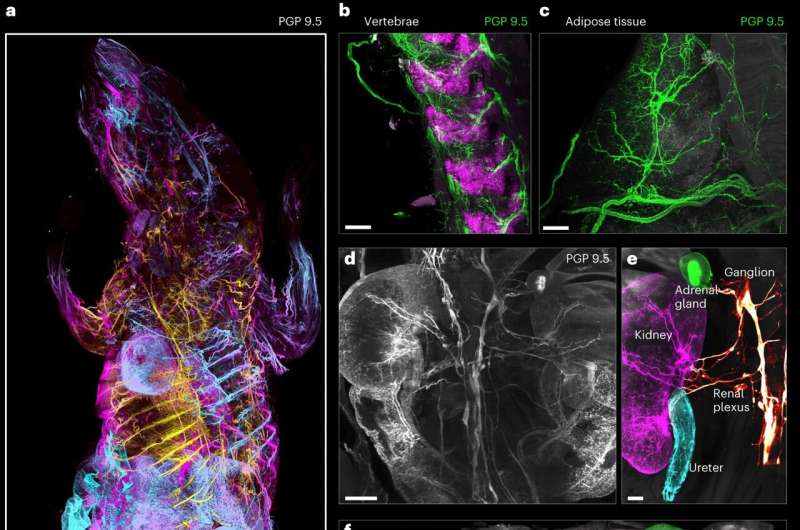This article has been reviewed according to Science X's editorial process and policies. Editors have highlighted the following attributes while ensuring the content's credibility:
fact-checked
peer-reviewed publication
trusted source
proofread
WildDISCO: Visualizing whole bodies in unprecedented detail

Researchers developed a new method called wildDISCO that uses standard antibodies to map the entire body of an animal using fluorescent markers. This revolutionary technique provides detailed 3D maps of structures, shedding new light on complex biological systems and diseases. WildDISCO has the potential to transform our understanding of intricate processes in health and disease and paves the way for exciting advancements in medical research. This technology was now introduced in Nature Biotechnology.
In the past, scientists relied on genetically modified animals or specialized labels to make specific structures and cells of interest visible in the entire body of an animal. But these approaches are expensive and time-consuming to create, especially when it comes to body-wide systems such as the nervous system.
A team of scientists from Helmholtz Munich, the LMU University Hospital and the Ludwig-Maximilians Universität München (LMU) now introduced a new method called wildDISCO, which makes use of standard antibodies to map whole bodies of mice. This ultimately enables the creation of detailed three-dimensional maps of normal and diseased structures in mammalian bodies in an easy-to-use and cost-efficient way.
In detail, the workflow of wildDISCO includes the distribution of antibodies coupled with a fluorescence tag in the whole body of a no longer living animal by perfusion of the blood vasculature followed by optical clearing of the animal and light-sheet fluorescence microscopy. The scientists detect a fluorescence signal where a specific antibody is bound to the structure, molecule, or cell of interest. Advanced computational tools create body-wide maps of all the specific locations where a molecule of interest is present throughout the body.
A crucial factor for the success of this project was finding a way to uniformly distribute a fairly large antibody homogeneously throughout every cell of an animal. Prof. Ali Ertürk and his team identified a specific compound, which enhances cell membrane permeability and facilitates deep and even penetration of standard antibodies without aggregation.
Ali Ertürk explains the vision behind the project: "Knowing where each protein is expressed in the body is essential for developing a comprehensive understanding of how the body works and what goes wrong in complex diseases."
WildDISCO provides online body maps for the scientific community
Using wildDISCO, the researchers were able to create detailed maps of cellular structures leading to entire mouse body atlases, focusing on the nervous system, lymphatic vessels, blood vessels, and immune cells. With this approach, they already discovered that the gut microbiome plays a significant role in the development of the enteric nervous system. They also mapped tumor-associated lymphoid structures (TLS) in relation to breast cancer spread which will provide insights into how these structures affect the immune response to tumors.
Furthermore, these atlases are not just in use at Helmholtz Munich but display a significant impact on the whole scientific community. Therefore, the high-resolution images are available on their website as online atlases. First authors Dr. Hongcheng Mai and Dr. Jie Luo from the Ertürk lab at Helmholtz Munich emphasize the benefits of whole-body atlases: "Our online atlases have already generated data for published papers. Other scientists have obtained critical data from our atlases, saving time, resources, and reducing animal use."
AI integration: Predicting disease progression without the use of animal models in research
The method can already facilitate modeling of complex biological systems and diseases by for example outlining the path of cancer metastasis and whether the designed treatments reach every single cancer micrometastasis. Currently, the Helmholtz Munich team works on further enhancing wildDISCO's capabilities. The scientists envision that in the future the technology allows for instance the simultaneous use of numerous antibodies to enable the modeling of multiple-complex systems together.
In addition to that, the high-quality, large-scale imaging data generated by wildDISCO is what is needed for the training of artificial intelligence (AI) algorithms, which thrive on large data sets. "Now imagine what we can do with these maps when you combine them with the power of deep learning," says Ertürk. The team is committed to harnessing the power of AI to simulate complex biological systems, with the ultimate goal of understanding diseases and developing new treatments more efficiently via computational predictions without the need for further animal experiments.
More information: Mai, H. et al, Whole-body cellular mapping in mouse using standard IgG antibodies, Nature Biotechnology (2023). DOI: 10.1038/s41587-023-01846-0 www.nature.com/articles/s41587-023-01846-0
Journal information: Nature Biotechnology
Provided by Helmholtz Association of German Research Centres





















